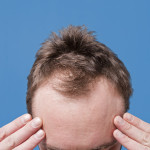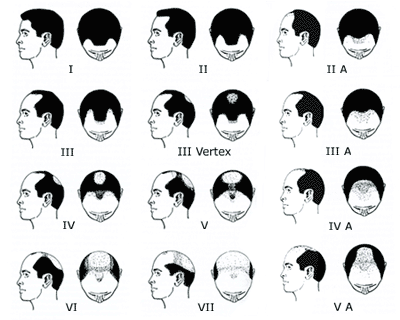 Have you noticed that your hair is getting thinner or that your hairline is receding? Teenage guys and young men are sometimes affected with male pattern baldness. In fact, it’s the most common cause of hair loss among adolescents, so if you have it, you’re not alone. Read on to learn more.
Have you noticed that your hair is getting thinner or that your hairline is receding? Teenage guys and young men are sometimes affected with male pattern baldness. In fact, it’s the most common cause of hair loss among adolescents, so if you have it, you’re not alone. Read on to learn more.
What causes this type of hair loss?
Male pattern baldness (medical name: Androgenetic Alopecia) is caused by a combination of androgens (male hormones) and genes (features that you inherit and pass down to your children). In guys, androgens work to develop male sexual characteristics such as penis growth, muscle development, and hair growth. Your genes are what determine the physical traits that are passed down to you from your parents.
Why is it called male pattern baldness?
Male pattern baldness gets its name because the hair falls out from the scalp in the same pattern in most guys. Take a look at the image below to see the Norwood-Hamilton scale of male pattern baldness. The images represent the way the hairline usually looks. Type “I” is the least amount of hair loss and Type “V A” is the most amount of hair loss. When girls lose their hair it’s called “female pattern hair loss” because their hair falls out in a different “pattern” than a guy’s does.

Is male pattern baldness common?
Yes. About 16% of boys ages 15-17 have male pattern baldness. A research study showed that 30% of Caucasian (white) males showed signs of male pattern baldness by age 30, 50% by age 50, and about 80% of males have hair loss by the time they are 70. Male pattern baldness is less common among Asian and African American men than Caucasian men.
When do guys usually start losing their hair?
Male pattern baldness usually begins when a guy is in his 30’s or 40’s, but it can also happen during the teen years, although it is much less common. Guys often say that they notice that their hair loss “comes and goes” meaning that at certain times they realize their hair is becoming thin and other times they may not notice anymore hair loss for a while.
I’m losing my hair – should I see my health care provider?
Yes. If you’re losing your hair, it’s a good idea to make an appointment with your health care provider (HCP) to get checked out. Sometimes hair loss can happen as a result of medical conditions such as low thyroid levels. It can also happen as a side effect of using certain medications such as anabolic steroids.
I heard that you’ll only lose your hair if someone on your mom’s side of the family lost his hair. Is that true?
No, that’s a myth. Male pattern baldness can be inherited (passed down) from either side of the family, mom’s or dad’s.
What can I do about my hair loss?
If your hair is thinning or falling out, you have options to consider after seeing your HCP. You could do nothing at all, shave your head, or use medication that helps hair growth.
Doing nothing: If your hair loss isn’t due to a physical condition, there’s no medical reason for you to treat it. Losing your hair won’t make you any less healthy. Some guys feel totally comfortable with their hair loss, and that’s great!
Shaving your head: Many guys really like the way they look with a shaved head. In fact, it’s a popular style.
Some bald men you might recognize:
- Kevin Garnett, NBA all-star
- Vin Diesel, actor
- Kelly Slater, pro surfer
- Chris Daughtry, singer
- Jason Statham, actor
- Tony Dungy, NFL football coach
- Moby, musician
Medication: If you feel that you want to treat your hair loss, the FDA (Food and Drug Administration) has approved two medications for use in men in the United States.
- Minoxidil: Minoxidil (also known as Rogaine®) is a medicine that works to promote hair growth. It comes in two forms that are applied to your scalp: a solution or a foam. You can buy it over-the-counter at a local pharmacy or supermarket. If you use Rogaine®, make sure to read the directions carefully. Minoxidil should be taken for at least two times a day for at least 4 months to see any early results.
- Finasteride: Finasteride (also known as Propecia®) is another medicine that supports hair growth. It comes as a tablet (or pill). You have to have a prescription from your health care provider in order to get this medicine.
Light therapy: Studies have shown that low levels of light therapy may help stimulate hair growth. Further studies are needed to figure out how much light and how often works the best.
Topical products that lessen the appearance of hair loss: You may discover products and hairpieces that disguise hair loss. These include: wigs, toupees, and sprays/powders that color the scalp.
Surgery: Hair transplantation using “follicular units” or taking a group of hair follicles from a nonbalding area is the most common and effective surgical procedure. It is a complicated procedure and it’s rarely covered by insurance.
Source: Read Full Article





